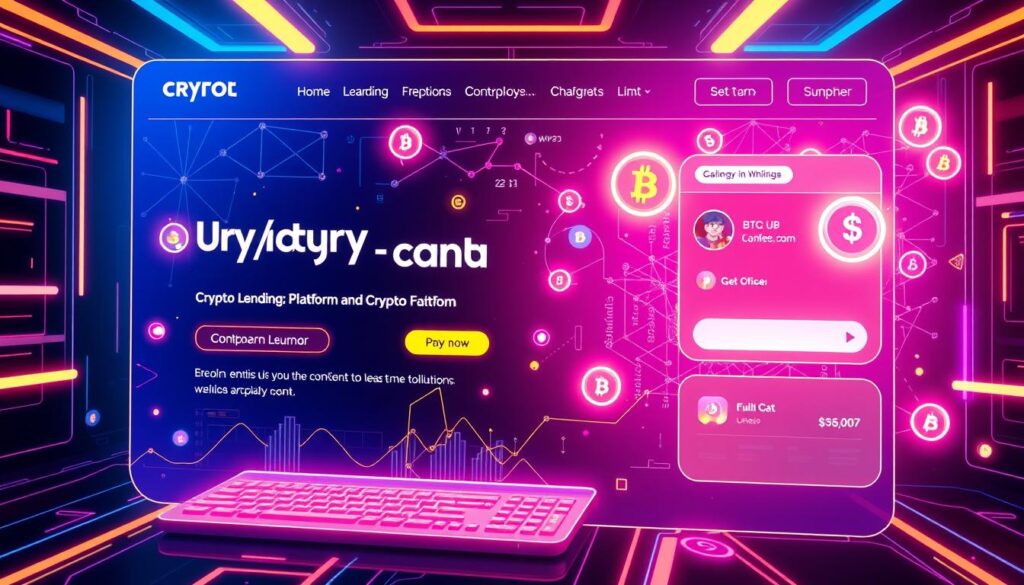Now Reading: Crypto-Based Peer-to-Peer Lending: A Complete Guide
- 01
Crypto-Based Peer-to-Peer Lending: A Complete Guide
Crypto-Based Peer-to-Peer Lending: A Complete Guide

In the rapidly evolving world of finance, cryptocurrencies and blockchain technology are revolutionizing traditional lending practices. Crypto-based peer-to-peer lending, a segment of the broader Decentralized Finance (DeFi) landscape, has emerged as a transformative force in the lending industry. This comprehensive guide delves into the intricacies of this innovative financial solution, exploring its fundamental concepts, key benefits, potential risks, and the future trends that are shaping the crypto lending landscape.
Cryptocurrencies, powered by blockchain technology, have introduced a new paradigm in finance, offering greater transparency, accessibility, and efficiency. By integrating cryptocurrencies into the peer-to-peer lending model, crypto-based lending platforms are challenging the status quo and providing borrowers and lenders with a more decentralized and empowered financial ecosystem.
Key Takeaways
- Crypto-based peer-to-peer lending leverages blockchain technology to facilitate direct lending and borrowing between individuals or entities, bypassing traditional financial institutions.
- This innovative model offers lower fees, increased accessibility for borrowers, and the potential for higher returns for lenders, making it an attractive alternative to traditional lending practices.
- However, crypto-based lending also carries risks such as market volatility, regulatory concerns, and security risks, which must be carefully considered by both borrowers and lenders.
- The regulatory landscape for crypto lending is evolving, with different regions approaching the sector in unique ways, and future trends point to increased adoption and integration of decentralized finance (DeFi) platforms.
- Understanding the best practices for both borrowers and lenders, as well as staying informed about the latest developments in the crypto lending space, is crucial for navigating this dynamic financial landscape.
Understanding Crypto-Based Peer-to-Peer Lending
Cryptocurrency has revolutionized the lending landscape, giving rise to a new era of peer-to-peer (P2P) lending platforms. These innovative Cryptocurrency Loans and P2P Lending Platforms leverage blockchain technology to facilitate secure, transparent transactions between borrowers and lenders without the need for traditional financial intermediaries.
Definition and Overview
Crypto-based P2P lending is a financial model that allows individuals to borrow and lend digital assets, such as cryptocurrencies, directly with each other. This decentralized approach eliminates the involvement of banks, credit unions, or other centralized institutions, empowering users to take control of their financial decisions.
Key Concepts in Peer-to-Peer Lending
At the core of crypto-based P2P lending are several key concepts:
- Decentralization: The platform operates on a decentralized blockchain network, ensuring transparency and eliminating the need for a central authority.
- Anonymity: Transactions are conducted pseudonymously, with participants identified by their blockchain addresses rather than personal identities.
- Collateralization: Borrowers typically provide digital assets as collateral to secure their Cryptocurrency Loans, reducing the risk for lenders.
- Interest Rates: Lenders can earn a return on their investments by providing Blockchain Lending, with interest rates determined by market forces.
How Cryptocurrency Integrates into the Model
Cryptocurrency is the backbone of crypto-based P2P lending platforms. Borrowers and lenders utilize digital assets, such as Bitcoin or Ethereum, to facilitate transactions. The use of blockchain technology ensures secure, transparent, and tamper-resistant recordkeeping, creating a trustworthy environment for all participants.
By embracing the power of Cryptocurrency Loans and P2P Lending Platforms, individuals can access financial services without the constraints of traditional banking systems, fostering financial inclusion and empowerment.
The Evolution of Lending Practices
The lending landscape has undergone a remarkable transformation in recent years, transitioning from traditional banking models to innovative Crypto-Based Peer-to-Peer Lending solutions. This evolution has been driven by the rise of Decentralized Finance (DeFi) and the integration of blockchain technology into the lending ecosystem.
Traditional Lending vs. Crypto Lending
Conventional lending practices have long relied on centralized financial institutions, where borrowers must navigate complex application processes and face high fees. In contrast, Blockchain Lending empowers individuals to lend and borrow directly, streamlining the transaction process and reducing intermediary costs.
Historical Context of Peer-to-Peer Lending
The concept of peer-to-peer lending is not entirely new, as it has roots dating back to the early 2000s. However, the advent of cryptocurrency and blockchain technology has revolutionized this model, making it more accessible, transparent, and secure.
Impact of Technology on Lending Solutions
The integration of blockchain and other cutting-edge technologies has had a profound impact on the lending industry. Smart contracts, decentralized platforms, and real-time data analysis have enabled Crypto-Based Peer-to-Peer Lending to offer faster approvals, lower interest rates, and greater accessibility for both borrowers and lenders.
| Characteristic | Traditional Lending | Crypto Lending |
|---|---|---|
| Application Process | Complex and time-consuming | Streamlined and efficient |
| Fees | High administrative and intermediary costs | Lower fees due to reduced overhead |
| Accessibility | Limited to those with established credit history | Inclusive and open to a wider range of borrowers |
| Transparency | Limited visibility into lending decisions | Increased transparency through blockchain technology |
The evolution of lending practices, driven by the emergence of Decentralized Finance (DeFi) and the integration of blockchain technology, has led to the rise of Crypto-Based Peer-to-Peer Lending. This innovative approach to lending has the potential to revolutionize the financial landscape, offering a more accessible, efficient, and transparent alternative to traditional banking models.
How Crypto Peer-to-Peer Lending Works
Crypto peer-to-peer (P2P) lending platforms offer a unique approach to borrowing and lending, leveraging the power of blockchain technology and smart contracts. These platforms streamline the lending process, making it more accessible and efficient for both borrowers and lenders.
Setup of a Lending Platform
The setup of a crypto P2P lending platform typically involves the creation of a decentralized application (dApp) on a blockchain network. This dApp serves as the interface where borrowers and lenders can connect, negotiate loan terms, and execute transactions. The platform may also integrate with various Lending Protocols to facilitate the lending process.
Role of Smart Contracts
At the heart of crypto P2P lending are Smart Contracts. These self-executing contracts automatically enforce the agreed-upon terms and conditions of a loan, ensuring transparency and reducing the risk of default. Smart contracts handle the entire loan lifecycle, from application and approval to repayment and collateral management.
The Borrower and Lender Experience
Borrowers on crypto P2P Lending Platforms can access loans quickly and conveniently, often without the need for extensive credit checks or collateral. Lenders, on the other hand, can earn attractive returns by providing funds to verified borrowers. Both parties can monitor the loan status and repayment progress through the platform’s user-friendly interface.
Leading crypto lending protocols, such as Aave and Compound, have gained popularity for their innovative approaches to P2P lending. These protocols leverage smart contracts to automate the lending process, offering a seamless experience for borrowers and lenders alike.

By understanding the setup, the role of smart contracts, and the experiences of borrowers and lenders, you can gain a comprehensive understanding of how crypto peer-to-peer lending works in practice.
Benefits of Crypto-Based Peer-to-Peer Lending
The rise of Cryptocurrency Loans and Decentralized Finance (DeFi) has revolutionized the traditional lending landscape, introducing a new era of Crypto-Based Peer-to-Peer Lending. This innovative approach offers a multitude of advantages that are transforming the financial sector.
Lower Fees and Costs
One of the primary benefits of crypto-based peer-to-peer lending is the significant reduction in fees and costs. By eliminating the intermediaries and administrative overhead associated with traditional financial institutions, these platforms can offer more competitive rates to both borrowers and lenders. This translates to substantial savings for individuals, making Cryptocurrency Loans a more accessible and affordable option.
Accessibility for Borrowers
Crypto-Based Peer-to-Peer Lending platforms have opened the doors to financial inclusion, providing access to Cryptocurrency Loans for individuals who may have been underserved or excluded from traditional lending systems. The decentralized nature of these platforms allows for greater flexibility and streamlined approval processes, empowering borrowers who might have struggled to secure loans from conventional sources.
Potential for High Returns for Lenders
For lenders, Crypto-Based Peer-to-Peer Lending offers the potential for higher returns compared to traditional investment options. By directly participating in the lending process, lenders can earn competitive interest rates on their Cryptocurrency Loans, potentially generating greater yields on their capital. This increased earning potential makes Decentralized Finance (DeFi) an attractive option for those seeking to diversify their investment portfolio.
The advantages of Crypto-Based Peer-to-Peer Lending are clear: lower fees, improved accessibility, and the opportunity for enhanced returns. As the adoption of Decentralized Finance (DeFi) continues to grow, these innovative lending platforms are poised to reshape the financial landscape, empowering individuals and driving greater financial inclusion.
Risks Associated with Crypto Lending
While the world of Crypto Collateralization, Blockchain Lending, and Cryptocurrency Loans offers exciting opportunities, it also comes with inherent risks that borrowers and lenders must be aware of. From market volatility to regulatory concerns and security threats, navigating the crypto lending landscape requires a keen understanding of these potential pitfalls.
Market Volatility
The highly volatile nature of cryptocurrencies can have a significant impact on crypto-based lending. Sudden price swings can affect the value of collateral, potentially leading to liquidation of borrowers’ assets or unexpected losses for lenders. Careful risk management and close monitoring of market trends are crucial to mitigate these challenges.
Regulatory Concerns
The regulatory landscape for Crypto Lending is constantly evolving, with different regions and jurisdictions adopting varied approaches. Navigating this complex regulatory environment can be a significant hurdle, as changes in rules and policies can impact the operations and viability of lending platforms. Staying informed about the latest regulatory developments is essential for both borrowers and lenders.
Security Risks: Hacking and Fraud
- Cyber attacks and hacking incidents can compromise the security of lending platforms, leading to the loss of funds and personal data.
- Fraudulent activities, such as identity theft or loan application scams, pose a constant threat to the integrity of the Cryptocurrency Loans ecosystem.
- Robust security measures, including multi-factor authentication and regular audits, are critical to mitigate these risks and protect the interests of all participants.
While the potential rewards of Crypto Collateralization and Blockchain Lending are enticing, it is crucial for borrowers and lenders to thoroughly understand and actively manage the associated risks. By staying informed, employing prudent risk management strategies, and partnering with reputable lending platforms, users can navigate the crypto lending landscape with greater confidence and security.
Selecting the Right Crypto Lending Platform
Navigating the world of P2P Lending Platforms can be daunting, but with the right factors in mind, you can find the crypto lending platform that best suits your needs. Whether you’re a borrower seeking favorable terms or a lender looking to earn high returns, understanding the key features to consider is crucial.
Important Features to Consider
When evaluating Crypto-Based Peer-to-Peer Lending platforms, pay close attention to factors such as security measures, interest rates, loan-to-value (LTV) ratios, and the overall user experience. Ensure the platform has robust security protocols in place to protect your assets, and compare interest rates to find the most competitive options.
Top Platforms in the Market
Some of the leading DeFi Lending platforms in the market include Aave, Compound, and Celsius Network. Each platform offers unique features, interest rates, and supported assets, so it’s essential to research and compare them to find the best fit for your needs.
Reputation and Community Feedback
Evaluating a platform’s reputation and community feedback can provide valuable insights into its reliability, transparency, and overall user satisfaction. Engage with online forums, read reviews, and consider the platform’s track record to make an informed decision that aligns with your risk tolerance and investment goals.

Selecting the right crypto lending platform requires a careful consideration of various factors, from security and interest rates to user experience and community feedback. By conducting thorough research and understanding your needs, you can navigate the P2P Lending Platforms landscape and find the solution that best fits your Crypto-Based Peer-to-Peer Lending goals.
Regulatory Landscape for Crypto Lending
As the Decentralized Finance (DeFi) ecosystem continues to evolve, the regulatory landscape surrounding Crypto-Based Peer-to-Peer Lending has become increasingly complex. Governments and financial authorities around the world are grappling with how to approach this emerging industry, balancing the need for innovation with the imperative to protect consumers and maintain financial stability.
Overview of Current Regulations
Currently, the regulatory framework for Blockchain Lending varies significantly across different regions. Some countries, such as the United States and the European Union, have begun to implement specific guidelines and rules for Crypto-Based Peer-to-Peer Lending platforms, while others have taken a more hands-off approach or even banned certain crypto-lending activities altogether.
How Different Regions Approach Crypto Lending
- In the United States, the Securities and Exchange Commission (SEC) and the Commodity Futures Trading Commission (CFTC) have taken the lead in regulating Crypto-Based Peer-to-Peer Lending, focusing on issues such as consumer protection, anti-money laundering, and the classification of crypto assets.
- The European Union has proposed the Markets in Crypto-Assets (MiCA) regulation, which aims to provide a harmonized framework for the regulation of Blockchain Lending and other crypto-related activities across the EU.
- In Asia, countries like Singapore and Japan have taken a more progressive approach, with regulations that seek to foster innovation while ensuring appropriate safeguards are in place.
- On the other hand, countries like China have imposed strict restrictions on Crypto-Based Peer-to-Peer Lending, effectively banning many related activities.
Future Trends in Regulation
As the Decentralized Finance (DeFi) landscape continues to evolve, experts predict that the regulatory environment for Crypto-Based Peer-to-Peer Lending will become increasingly complex and nuanced. Policymakers will likely focus on issues such as consumer protection, anti-money laundering, and the integration of Blockchain Lending with traditional financial systems. Ongoing discussions and debates around the appropriate regulatory approach will shape the future of this dynamic industry.
Best Practices for Borrowers
As the crypto lending landscape continues to evolve, it’s essential for borrowers to understand the best practices that can lead to successful loan applications. From assessing loan requirements to calculating appropriate loan-to-value ratios, this section provides a roadmap for navigating the world of Cryptocurrency Loans and Crypto Collateralization.
Assessing Loan Requirements
Before applying for a loan, borrowers should carefully review the requirements set by the P2P Lending Platforms they’re considering. This includes understanding the minimum collateral requirements, credit history checks, and any additional documentation needed to support the loan application. Thorough research can help borrowers avoid unexpected roadblocks and ensure a smoother approval process.
Calculating Loan-to-Value Ratios
- Loan-to-Value (LTV) ratios are a critical factor in crypto lending, as they determine the amount a borrower can receive based on the value of their collateral.
- Borrowers should familiarize themselves with the LTV calculation methods used by different platforms and ensure they maintain a healthy ratio to minimize the risk of liquidation.
- Regularly monitoring the value of their collateral and adjusting their loan amounts accordingly can help borrowers stay within the platform’s LTV guidelines.
Tips for Loan Applications
- Prepare a comprehensive loan application, including detailed financial information, collateral details, and a clear explanation of the purpose of the loan.
- Build a strong credit history and maintain a healthy credit score to increase the chances of loan approval.
- Communicate proactively with the lending platform’s customer support team to understand any additional requirements or concerns they may have.
- Be prepared to provide additional documentation or information as requested by the platform to support the loan application.
By following these best practices, borrowers can navigate the Cryptocurrency Loans and Crypto Collateralization landscape with confidence, increasing their chances of securing the financing they need.
Best Practices for Lenders
As the world of DeFi Lending continues to evolve, it’s crucial for lenders to adopt best practices to maximize their returns and minimize their risks. In the realm of Crypto-Based Peer-to-Peer Lending, diversification, borrower creditworthiness evaluation, and understanding interest rates are key considerations for savvy lenders.
Diversifying Investments in Lending
Experienced lenders understand the importance of diversifying their lending portfolios. By spreading their investments across multiple borrowers, platforms, and Lending Protocols, lenders can mitigate the impact of individual defaults or market volatility. This approach helps to stabilize returns and reduce overall risk exposure.
Evaluating Borrower Creditworthiness
In the decentralized world of DeFi Lending, traditional credit scoring mechanisms may not always apply. Lenders must develop their own methods for assessing borrower creditworthiness, such as analyzing on-chain data, reviewing collateral, and considering the borrower’s track record within the Crypto-Based Peer-to-Peer Lending ecosystem.
Understanding Interest Rates
Interest rates in the Crypto-Based Peer-to-Peer Lending market can vary significantly across platforms and Lending Protocols. Lenders should carefully compare rates, considering factors such as loan duration, collateral requirements, and platform fees. By understanding the nuances of interest rate structures, lenders can optimize their returns while making informed decisions.
By adopting these best practices, lenders in the Crypto-Based Peer-to-Peer Lending space can navigate the dynamic landscape with confidence, diversifying their investments, evaluating borrower creditworthiness, and capitalizing on favorable interest rates.

| Diversification | Borrower Creditworthiness | Interest Rates |
|---|---|---|
| Spread investments across multiple borrowers, platforms, and protocols | Analyze on-chain data, review collateral, consider borrower track record | Compare rates, consider loan duration, collateral requirements, and platform fees |
The Role of Decentralized Finance (DeFi)
In the rapidly evolving world of finance, Decentralized Finance (DeFi) has emerged as a game-changer, significantly impacting the lending landscape. DeFi is a blockchain-based ecosystem that aims to provide a decentralized alternative to traditional financial services, including lending and borrowing.
What is DeFi?
DeFi is a collective term for financial products and services built on top of blockchain networks, primarily Ethereum. It utilizes smart contracts to automate and streamline financial transactions without the need for intermediaries, such as banks or financial institutions.
How DeFi Changes the Lending Landscape
The integration of blockchain lending within the DeFi ecosystem has revolutionized the traditional lending model. DeFi platforms enable peer-to-peer lending and borrowing, allowing users to directly lend and borrow cryptocurrencies without the involvement of centralized financial institutions. This decentralized approach eliminates the need for credit checks, collateral, and lengthy approval processes, making the lending process more accessible and efficient.
Examples of DeFi Platforms for Lending
Several prominent DeFi platforms have emerged as leaders in the crypto lending space, offering innovative solutions and features:
- Compound – A decentralized lending and borrowing protocol that allows users to earn interest on their crypto assets or borrow against their holdings.
- Aave – A DeFi lending platform that enables users to lend, borrow, and earn interest on a variety of cryptocurrencies.
- Maker – A decentralized autonomous organization (DAO) that allows users to create and manage the DAI stablecoin, which can be used for DeFi lending and borrowing.
These DeFi platforms and others are transforming the way individuals and institutions access and participate in the lending market, leveraging the power of blockchain technology and smart contracts to create a more inclusive and transparent financial ecosystem.
The Future of Crypto Peer-to-Peer Lending
As the Crypto-Based Peer-to-Peer Lending market continues to evolve, industry experts predict an exciting future filled with new trends and innovations. This emerging sector is poised to disrupt traditional finance, offering a more accessible and transparent lending experience backed by the power of blockchain technology.
Predictions and Trends to Watch
Experts foresee a surge in mainstream adoption of Cryptocurrency Loans as more individuals and businesses embrace the benefits of Blockchain Lending. The integration of decentralized finance (DeFi) protocols is expected to enhance the user experience, provide greater transparency, and reduce intermediary fees. Additionally, the use of advanced analytics and machine learning algorithms is anticipated to improve credit risk assessment and streamline the lending process.
The Potential Impact on Traditional Finance
The rise of Crypto-Based Peer-to-Peer Lending is likely to have a significant impact on traditional financial institutions. As this innovative lending model gains traction, it may challenge the dominance of conventional banks and lending institutions, forcing them to adapt their strategies and offerings to remain competitive. This shift could lead to more inclusive and efficient financial services, benefiting both borrowers and lenders.
Innovations on the Horizon
- The integration of artificial intelligence and machine learning to enhance risk management and underwriting processes.
- The development of cross-chain compatibility, allowing for seamless integration between different blockchain networks.
- The emergence of decentralized identity solutions to improve user authentication and data security.
- The exploration of new collateral types, such as non-fungible tokens (NFTs), to expand lending opportunities.
As the Crypto-Based Peer-to-Peer Lending landscape continues to evolve, these predictions and trends suggest an exciting future filled with increased accessibility, greater transparency, and innovative solutions that could reshape the way we think about lending and borrowing.
“The future of Crypto-Based Peer-to-Peer Lending lies in its ability to democratize finance, empowering individuals and businesses with more inclusive and efficient lending solutions.”
| Trend | Description | Potential Impact |
|---|---|---|
| DeFi Integration | Increased adoption of decentralized finance protocols in the lending ecosystem | Greater transparency, reduced intermediary fees, and enhanced user experience |
| Advanced Analytics | Leveraging AI and machine learning for improved credit risk assessment and underwriting | More efficient lending decisions, reduced default rates, and increased access to credit |
| Cross-Chain Compatibility | Seamless integration between different blockchain networks for wider lending opportunities | Increased liquidity, reduced fragmentation, and greater flexibility for borrowers and lenders |
Case Studies of Successful Platforms
In the rapidly evolving world of crypto-based peer-to-peer lending, there are notable success stories that showcase the potential of this innovative financial model. By examining the factors that contributed to the success of leading P2P Lending Platforms, we can gain valuable insights for aspiring entrepreneurs and investors.
Notable Success Stories
One standout example is Compound, a decentralized DeFi Lending protocol that has garnered significant attention and adoption within the crypto community. Compound’s seamless integration of smart contracts and its commitment to transparency have been key drivers of its success.
Lessons Learned from Failed Ventures
While the crypto lending landscape has witnessed several triumphant stories, it has also seen its fair share of failed Crypto-Based Peer-to-Peer Lending ventures. By examining the missteps and challenges faced by these platforms, we can identify essential lessons for aspiring entrepreneurs and investors.
Key Takeaways for New Investors
The experiences of both successful and failed P2P Lending Platforms highlight the importance of robust risk management, regulatory compliance, and a deep understanding of the crypto lending ecosystem. By learning from these case studies, new investors can make more informed decisions and navigate the complexities of the DeFi Lending landscape with greater confidence.
As the Crypto-Based Peer-to-Peer Lending industry continues to evolve, the lessons learned from successful and failed platforms will be instrumental in shaping the future of this dynamic financial sector.
Conclusion: The Future of Lending
As we have explored throughout this guide, the integration of cryptocurrency and blockchain technology has revolutionized the lending landscape, giving rise to the concept of crypto-based peer-to-peer lending. The decentralized nature of this model offers significant advantages, including lower fees, increased accessibility for borrowers, and the potential for high returns for lenders.
Summary of Key Points
This guide has delved into the key concepts, evolution, and inner workings of crypto-based peer-to-peer lending. We’ve examined the benefits and risks associated with this innovative financial solution, as well as the regulatory landscape and best practices for both borrowers and lenders. The role of Decentralized Finance (DeFi) in shaping the future of lending has also been highlighted, showcasing the transformative potential of blockchain technology.
Final Thoughts on the Crypto Lending Landscape
As the crypto-based peer-to-peer lending industry continues to evolve, it’s clear that this model has the potential to disrupt traditional finance. With the increasing adoption of cryptocurrencies and the growing popularity of DeFi platforms, the future of lending looks poised to become more efficient, transparent, and accessible to a wider global audience.
Call to Action for Readers
If you’re intrigued by the possibilities of crypto-based peer-to-peer lending, we encourage you to further explore this dynamic financial sector. Stay informed about the latest developments, research reputable lending platforms, and consider the potential benefits and risks before embarking on your own lending journey. The future of lending is here, and the opportunity to be a part of this transformative shift is now.
FAQ
What is crypto-based peer-to-peer lending?
Crypto-based peer-to-peer lending is a financial model that utilizes blockchain technology and cryptocurrencies to facilitate direct lending between borrowers and lenders, without the involvement of traditional financial intermediaries.
How does cryptocurrency integrate into the peer-to-peer lending model?
Cryptocurrencies play a crucial role in crypto-based peer-to-peer lending by serving as the medium of exchange and collateral for loans. Blockchain technology enables secure, transparent, and decentralized transactions between borrowers and lenders.
What are the key benefits of crypto-based peer-to-peer lending?
The key benefits of crypto-based peer-to-peer lending include lower fees and costs, increased accessibility for borrowers, and the potential for higher returns for lenders compared to traditional investment options.
What are the main risks associated with crypto lending?
The main risks associated with crypto lending include market volatility, regulatory concerns, and security risks such as hacking and fraud. Proper risk mitigation strategies are necessary to navigate these challenges.
How can I choose the right crypto lending platform?
When selecting a crypto lending platform, it’s important to consider factors such as security measures, interest rates, user experience, and platform reputation, as well as feedback from the community.
What are the best practices for borrowers in the crypto lending space?
Best practices for borrowers include assessing loan requirements, calculating appropriate loan-to-value ratios, and following effective strategies for successful loan applications.
How can lenders maximize returns and minimize risks in crypto peer-to-peer lending?
Lenders can employ strategies such as diversifying investments, evaluating borrower creditworthiness, and understanding the nuances of interest rates across different lending platforms and protocols.
What is the role of Decentralized Finance (DeFi) in the crypto lending landscape?
Decentralized Finance (DeFi) protocols are reshaping the lending industry by providing decentralized, transparent, and automated lending solutions using smart contracts on the blockchain.
What are some predictions and trends for the future of crypto peer-to-peer lending?
The future of crypto peer-to-peer lending is expected to bring further technological innovations, increased adoption, and potential impacts on traditional financial institutions as the market continues to evolve.
Can you provide examples of successful and failed crypto lending platforms?
Case studies of both successful and failed crypto lending platforms offer valuable lessons for new investors and entrepreneurs, highlighting the critical factors that contribute to a platform’s success or failure.














